 In 2015, there were more than 467,000 bicycle-related injuries and more than 1,000 bicycle-related deaths in the United States, with most bicycle deaths’ occurring in urban areas and non-intersection locations, according to the Centers for Disease Control and Prevention. Before you ride, make sure you, your bicycle and your knowledge of the road are ready.
In 2015, there were more than 467,000 bicycle-related injuries and more than 1,000 bicycle-related deaths in the United States, with most bicycle deaths’ occurring in urban areas and non-intersection locations, according to the Centers for Disease Control and Prevention. Before you ride, make sure you, your bicycle and your knowledge of the road are ready.
“Bicyclists should be predictable, visible and aware as they move through their cities and neighborhoods,” said David Schwebel, Ph.D., professor at the University of Alabama at Birmingham College of Arts and Sciences. “By taking precautions before you ride and while you are riding, you can significantly decrease the risk of injury or death while riding a bicycle.”
Bicycle readiness
Almost 74 percent of fatal bicycle crashes involve head injury, according to a study in the Cochrane Reviews. It is crucial to protect your body while riding a bicycle, including your head.
“Helmets save lives,” said Bryan Fields, captain of Housing and Special Operations in the UAB Police Department. “If the helmet does not fit properly, it can leave important areas of the head exposed to injury.”
Find a helmet that fits snugly with the strap on. States have various laws regarding cyclists’ wearing helmets, but for safety it is recommend that everyone wear a helmet when riding. Cyclists should check to make sure the helmet is ANSI- or SNELL-approved by the federal government.
 David Schwebel, Ph.D.What a cyclist is wearing matters. Wear clothing that is bright or easily seen and fits tightly. Clothing that is easily seen allows drivers to see cyclists. This is especially important at dusk, at dawn and at night. A cyclist’s clothing should have reflectors on it or be bright in color. Avoid loose clothing that could get caught in the bicycle. Long pants and long sleeves could protect against scrapes but should fit tightly. In warmer weather, consider wearing knee and elbow pads.
David Schwebel, Ph.D.What a cyclist is wearing matters. Wear clothing that is bright or easily seen and fits tightly. Clothing that is easily seen allows drivers to see cyclists. This is especially important at dusk, at dawn and at night. A cyclist’s clothing should have reflectors on it or be bright in color. Avoid loose clothing that could get caught in the bicycle. Long pants and long sleeves could protect against scrapes but should fit tightly. In warmer weather, consider wearing knee and elbow pads.
“Avoid dark clothing when riding a bicycle,” Schwebel said. “Dark colors make it difficult for drivers of cars to see a bicyclist. If possible, I recommend not riding bicycles after dark, when it is harder for motorists to see cyclists.”
Assess your bicycle and its readiness to take the road. Go through a check list to make sure your bicycle is appropriately sized and maintained.
“Danger can occur if the bicycle fails at the wrong time,” Schwebel said. “Having a quick pre-ride checklist to ensure your bicycle is safe can decrease the risk of injury.”
Pre-ride checklist:
- Appropriate air in the tires
- Proper size of the bicycle
- Adjust the seat to fit height
- Reflectors on front and back of bicycle
- Check all parts to ensure they are properly working
- Grease chains, if needed
 Know the rules
Know the rules
Bicyclists are expected to know the rules of the road and use etiquette when riding. They are held to the same laws as motorists and should abide by them for the utmost in safety.
“Bicycles are considered vehicles when ridden in the street,” Fields said. “It is important to learn and follow the rules as a motorist and a cyclist to help protect anyone who is traveling.”
Rules of the road include:
- Never ride against the flow of traffic
- Obey all traffic laws
- Know pedestrians always have the right of way if riding on the sidewalk
- Use hand signals
- Look both ways before crossing the street
“If drivers know where you are going, they will be able to respond and avoid you, just as they would avoid other vehicles,” Schwebel said.
Using hand signals allows others to know what intentions are being communicated. Just as motorists do, tell others what you are doing and where you are going. The most important hand signals to know include left and right turns. Signal a left turn by extending the left hand out. To signal a right turn, extend the left arm out from the body pointing the forearm and hand up in a right angle.
“No matter where children are riding bicycles, it is important for parents to educate them on bicycle safety and provide supervision,” Schwebel said.
Parents should supervise children bicycling just as they would children walking on the road. Stay close, help with busy traffic areas, and monitor safety closely.